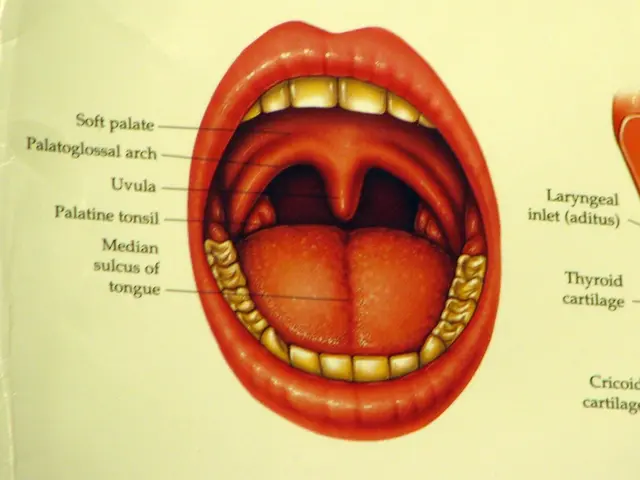Connection between Breast and Ovarian Cancer: Causes and Risk Factors
Rewritten Article:
Jackson here! Let's dive into the intriguing connection between breast and ovarian cancer. So, you wanna know if these two malignant beasties raise the odds of each other?
Well buckle up, cowboy (or cowgirl), 'cause there's some fascinating stuff ahead.
This dance between breast and ovarian cancer is mainly directed by genetic factors. Folks who carry mutations in the BRCA1 and BRCA2 genes are the main rock stars in this duet, as they're the ones who have an increased risky duet of both cancers.
Now, here's the deal - if you've had breast cancer, you might find yourself with a heightened risk of ovarian cancer. This risk climbs even more if your breast cancer is associated with those pesky BRCA gene mutations. However, this risk hike isn't really because of the cancer itself but due to the underlying genetic factors.
Research suggests that folks with breast cancer are approximately twice as likely to develop a subsequent primary ovarian cancer. On the flip side, those with ovarian cancer might experience a 1.6-fold increased risk of subsequent breast cancer. But don't worry, the risk varies with time since their first cancer diagnosis.
Ovarian cancer? It's got its own genetic connection with breast cancer. What can I say, these two cancers have each other wrapped around their chromosomes.
Now, let me break down some other shared risk factors for these two cancers:
- Genes: BRCA1 and BRCA2 take the lead, but around 10% of families with ovarian and breast cancer carry BRCA1 gene mutations, while 20% have BRCA2 mutations.
- Age: When it comes to ovarian cancer, it's mostly a late bloomer, usually cropping up in people over 40 years, while breast cancer tends to show up in those ages 55 or older.
- Weight: Keeping the scale balanced can help reduce the risk. Carrying extra pounds may cause higher estrogen levels, which can increase the risk of breast cancer.
- Pregnancy: Hitting the fertile age is crucial, as having a first child after 30 can cut down the risk. Never having kids? That's a risk factor, too.
- Not breastfeeding: This is another tick in the risk column.
- Hormone therapy after menopause: It can up the risk of breast cancer a bit.
So, can people reduce the risk of breast and ovarian cancer? Well, some factors are unchangeable. Mine, for example. But managing these unchangeable factors often means keeping a close eye, making lifestyle changes, and (in some cases) preventive medical procedures.
Changeable risk factors include:
- Weight: Achieving and maintaining a moderate weight (not too skinny, not too heavy) can help reduce the risk.
- Exercise: Regular physical activity can lower the risk of breast cancer. Evidence also points to some ovarian cancer protection.
- Alcohol: Cutting back on booze can help lower the risk of breast cancer.
- Oral contraceptives: Contraceptive pills might cut the risk of ovarian cancer, but they can slightly up the odds of breast cancer.
Now, let's talk about the outlook. A study from 2020 suggests that people with both primary breast cancer and primary ovarian cancer have a relatively favorable outlook, with 5- and 10-year overall survival rates of around 90%. But, if the time between the two cancers is short, that's a sign of a rougher road ahead.
Vigilance is key. If anyone experiences signs of breast or ovarian cancer, especially with a personal or family history of these diseases, they need to talk to a doctor. Early detection and prompt treatment are vital for improving outcomes.
Wanna dig deeper into cancer? Head over to our hub for more reliable information and resources on the subject.
FAQs
- Does ovarian cancer increase the risk of breast cancer? - yup, it sure does.
- Can breast cancer spread to the ovaries? - not super common, but it's possible, especially if the breast cancer is advanced or hormone receptor-positive or if you carry BRCA mutations.
- Who is at high risk of ovarian cancer? - folks with BRCA1 or BRCA2 gene mutations, a family history of ovarian, breast, or colorectal cancer, Lynch syndrome, endometriosis, never being pregnant, a late first pregnancy, age over 40 years.
- The connection between breast and ovarian cancer is driven largely by genetic factors, with mutations in the BRCA1 and BRCA2 genes being a significant risk factor.
- If someone has been diagnosed with breast cancer, they may face an increased risk of ovarian cancer, particularly if their breast cancer is associated with BRCA gene mutations.
- Research indicates that people with breast cancer are approximately twice as likely to develop a subsequent primary ovarian cancer.
- On the flip side, those with ovarian cancer might experience a 1.6-fold increased risk of subsequent breast cancer, but the risk changes over time since their first cancer diagnosis.
- Ovarian cancer shares a genetic connection with breast cancer, with around 10% of families with both cancers carrying BRCA1 gene mutations, and 20% having BRCA2 mutations.
- Weight, pregnancy, age, breastfeeding habits, hormone therapy after menopause, and a number of other factors can influence the risk of both breast and ovarian cancer.
- Some changeable risk factors for breast and ovarian cancer include maintaining a moderate weight, regular exercise, limiting alcohol consumption, using oral contraceptives, and being aware of personal and family medical history.
- A study from 2020 suggests that people with both primary breast cancer and primary ovarian cancer have a relatively favorable outlook, with 5- and 10-year overall survival rates of around 90%, but a short time between the two cancers is a sign of a rougher road ahead.








